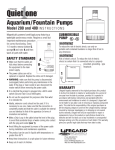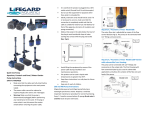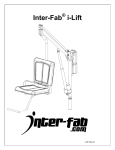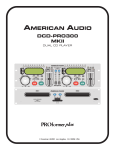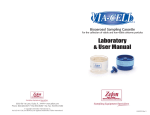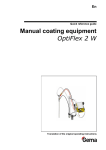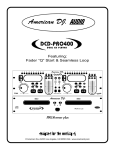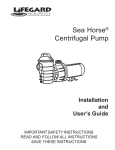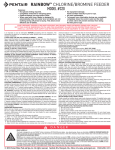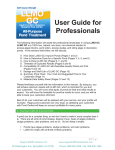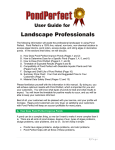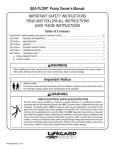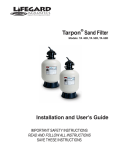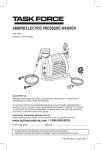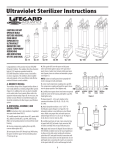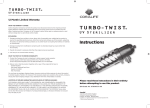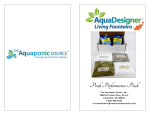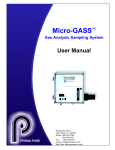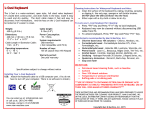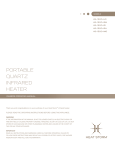Download Fluidized Bed Filter Instructions
Transcript
PARTS BREAKDOWN FB300 Item Quantity Description Part# 1. 2 3/4” MPT x 1/2” Barb Elbow 270248 2. 4’ 1/2” ID x 11/16” OD Valve Tubing 270247 3. 1 Check Valve Assembly 270245 4. 3 O-ring, Check Valve & Plugs 270228 5. 1 Tension Spring 270229 6. 1 #6 x 1/2” Screw 01045 7. 1 Tension Retainer 270222 8. 1 Mounting Bracket 270242 9. 1 Flow Control Valve 270220 10. 1 O-ring, Flow Control Valve 270227 11. 2 Valve Retainer Screw 01086 12. 1 Water Fall Assembly 270244 13. 2 Adjustment Screw 36021 14. 2 Plug 270218 15. 1 Media 270241 16. 1 Thread Seal Tape 175096 17. 3 Hose Clamp 175013 9. 7. 5. 6. 10. 4. 1. 3. 11. 12. 8. 11. 15. 13. 14. 13. 4. 16. 17. WARRANTY: LIFEGARD AQUATICS warrants the original purchaser of this equipment to be free from defects in workmanship or material for a period of one year from the date of installation, provided this equipment is installed in accordance with factory instructions and operated within the environment and limitations for which it was designed. Should any of the integral parts of the unit become defective within one year from the date of purchase, they will be repaired or replaced, if proven defective in workmanship or material in the opinion of the manufacturer. LIFEGARD AQUATICS will not be liable for any labor cost of removing or replacing component parts. This shall be the responsibility of the original purchaser, as will be the shipping charge to Lifegard’s plant. Damage or failure of any part of a unit covered by this warranty, which results from causes directly, or indirectly connected with the installation, operation, environment, use or willful abuse, including without limitations, improper repackaging and damage INSTRUCTION SHEET FB 300 INTRODUCTION 4. 2. FLUIDIZED BED FILTER 14. incurred in shipping, is not covered by this warranty. Unless state law provides otherwise, manufacturer will only be responsible for repair or replacement of any of its products or parts there of that are found to be defective, and will not bear the cost of any incidental or consequential damages arising out of the occurrence of such defect. This warranty gives you specific legal rights and you may also have other rights which vary from state to state. Due to its unique shape, the Lifegard Fluidized Bed Filter is an extremely efficient high capacity “biological” filter. Aquatic organisms excrete toxic ammonia as a metabolic waste product with additional ammonia produced as food and other organic matter breaks down and decomposes. This toxic ammonia (NH3) is converted to another toxic compound nitrite (NO2) by the Nitrosomonas species of bacteria. The nitrite is then converted to a relatively non toxic compound called nitrate (NO3) by the Nitrobacter species of bacteria. This process is known as “nitrification”. A “biological” filter is a vessel where nitrification occurs and soluable waste is removed. Beneficial bacteria attach to the media within the Lifegard Fluidized Bed Filter creating a thin film around the sand grains. Water is pumped up through the unit lifting the sand into a “fluidized bed”. The beneficial bacteria attached to the media draw in dissolved wastes (ammonia and nitrite) oxygen, supplied by Rainbow’s exclusive water fall device and other required nutrients from the passing water converting them to relatively harmless nitrate. The sand grains are in continual free fall through the water resulting in an excellent transfer capability between the liquid and the bacterial film on the media. The enormously high surface area combined with this excellent transfer capability creates the perfect habitat for bacterial growth. In addition, the sand grains bump into each other frequently knocking off excess debris and providing a self cleaning function which allows new areas for bacterial growth.The Lifegard Fluidized Bed Filter has been tested and proven to supply the highest level of effluent water quality and will respond quickly and efficiently to severe changes in ammonia levels caused by over feeding or the addition of too many fish at one time. To obtain highest water quality, a Lifegard Fluidized Bed Filter should be part of the system. CAPACITY MODEL FB 300 SYSTEM SIZE Up to 300 Gallons MEDIA WEIGHT 3 Lbs. SURFACE AREA 214 ft2 Multiple units can be connected together for larger volume installations or systems with extremely high bio-loads. Email: [email protected] www.lifegardaquatics.com FLOW RATE The Lifegard Fluidized Bed Filter is most effective at low rates. Lower flow rates increase the contact time between the bacteria and the toxic ammonia and nitrite compounds that they utilize. 5. UNDERNEATH AQUARIUM WITH A CANISTER FILTER 5A.Place filter in desired location next to the canister filter. Position the filter so 5A. that it can be plumbed on the outlet side of the canister filter. In steps 5B through 5E, refer to installation drawings in section #2 (Beside The Aquarium). 5B.Screw in the plugs on each side of the bottom manifold. Make sure the plug “o” rings are seated properly. In most cases, the bottom inlet ports will not be needed in this type of installation. 5C. Screw in the check valve assembly in top inlet port. Make sure check valve “o” ring is seated properly. 5D.Wrap thread seal tape on the male threads of the two 3/4” MPT x 1/2” barb elbow fittings provided. Wrap each fitting 5-7 times with thread seal tape. 5E. Screw one 3/4” MPT x 1/2” barb elbow fitting into the check valve assembly located at the top inlet port. Screw in the other elbow fitting into the outlet port located at the top of the unit. 5G.Turn off the valve on the outlet side of the canister filter and completely drain the flexible tubing on the outlet side of the canister filter. In most cases, it will be necessary to remove the “U” or “J” tube from the back of the aquarium. Cut the flexible tubing on the outlet side of the canister filter and plumb in line a by-pass valve and “tee” which will divert only a portion of the water from the canister filter and into the inlet port on the left side of the top manifold. Attach hose clamps and tighten accordingly. 5H.Attach one end of the 1/2” ID x 11/16” OD flexible tubing to the 3/4” MPT x 1/2” barb elbow located at the top outlet side of the filter. Attach hose clamps and tighten accordingly. 5I. Place the other end of the tubing up and over the side or back of the aquarium so that the water returns to the aquarium and agitates the surface to aerate the system. In some cases, flexible tubing can be attached to a rigid plastic “U” or “J” tube (not supplied in this unit) that hangs on the aquarium. Attach hose clamps to the rigid tube and tighten accordingly. 5J. Add media to the unit by following steps H, I, J, K, and L in section #1 (Hanging On The Aquarium). 5K.Open the by-pass valve completely. 5L. Carefully adjust the fluidization level by following steps P, Q, and R in section #1(Hanging On The Aquarium). 5M.Partially close the by-pass valve to direct more water into the filter only if proper fluidized is not achieved. 6A. 6. CONNECTING MULTIPLE UNITS TOGETHER 6A.Place each filter in desired location next to the aquarium system. Make sure unit is level on base. If it’s more desirable to hang the filters on the side or back of a aquarium or reservoir tank, please refer to steps E, F, and G in section #1 (Hanging On The Aquarium). 6B. Screw in plug into the top inlet port on each filter. Screw in another plug into the bottom inlet port on the right side of the last filter in line and the left side of the first filter in line. Make sure the plug “o” rings are seated properly. 6C. Screw in check valve assembly into the inlet port on the right side of the bottom manifold of first filter and the left side of the next filter. 6D. Wrap thread seal tape on the male threads of the two 3/4” MPT x 1/2” barb elbow fittings. Wrap each fitting 5-7 times with tape. 6E. Screw each of the 3/4” MPT x 1/2” barb elbow fittings into the outlet ports on the top side of each filter. Position the barb portion of the fitting straight up vertically. 6 6F. Attach one end of the 1/2” ID x 11/16” OD flexible tubing to the 3/4” MPT x 1/2” barb elbow located at the top outlet side of the filter. Place the other end of the tubing up and over the side or back of the aquarium so that the water returns to the aquarium and agitates the surface to aerate the system. In some cases, flexible tubing can be attached to a rigid plastic “U” or “J” tube (not supplied in this unit) that hangs on the aquarium. Repeat this for each filter used. Attach hose clamps where needed and tighten accordingly. 6G. A by-pass valve may be needed depending on what size pump is used. The by-pass valve will divert only a portion of the water from the pump to the filters. Refer to step 4E in section #4 (Underneath Aquarium with a Lifegard System). 6H. Add media to each filter by following steps H, I, J, K, L, in section #1 (Hanging On The Aquarium). 6I. Open by-pass valve completely. 6J. Carefully adjust the fluidization level of each filter by following the steps P, Q and R in section #1 (Hanging On The Aquarium). 6K. Partially close the by-pass valve to divert more water into the filters only if proper fluidization is not achieved. ADDING REPLACEMENT MEDIA Hanging Installations A. Turn off pump and wait a full 10 minutes for the media to settle into the bottom chamber. If you have lost media, the level of the media will be below the “Media Fill Level” label located on the right side of the clear chamber. B. Remove the retainer screws from the flow control valve located at the top outlet side of the filter. C. Pull the flow control valve straight up and remove. D. Pour in the media up to the “Media Fill Level” label on the unit. Wipe off any media that may be in the valve chamber with a dry cloth. Lubricate the valve and valve chamber with the Lifegard silicone lubricant supplied with the unit. E. Install the flow control valve back into the valve chamber making sure the “o” ring is seated properly and all parts are free of any debris or media. F. Screw in the two valve retainer screws. Below Tank Installations A. Turn off pump to Lifegard Modular System or canister filter. B. Completely drain flexible tubing on the outlet side of fluidized bed filter. C. Follow steps A, B, C, D, E, and F in the above section (Adding Replacement Media, Hanging Installations). ADDITIONAL EQUIPMENT REQUIRED Additional equipment is needed in order to achieve optimal water quality in your aquarium. This is vital to the health of your plants and animals as well as the nitrifying bacteria in your fluidized bed filter. Accumulation of large amounts of particulate and dissolved organic material will encourage the growth of other types of bacteria (heterotrophic) that will compete with the nitrifying bacteria for available space and nutrients. Additional equipment needed to reduce this accumulation of particulate and dissolved organic material will include the following: A. MECHANICAL FILTRATION This type of filter will trap and remove floating debris and should be cleaned routinely. A prefilter sponge should be attached to the pump to trap debris before it enters the fluidized bed filter. B. CHEMICAL FILTRATION This type of filter is usually filled with activated carbon that removes dissolved organic molecules. C. AERATION Additional aeration equipment is needed in order to maintain complete oxygen saturation in your aquarium system. This can be achieved with an air pump and diffuser as well as good water movement at the surface of the aquarium. Proper circulation is necessary in order to achieve oxygen saturation in your aquarium. D. ULTRAVIOLET STERILIZATION Ulrtaviolet sterilizers control the transmission of disease from one fish to another by killing free floating micro-organisms as they pass through the unit. The nitrifying bacteria are not killed because they are attached to the media within the fluidized bed filter and are not free floating. Ultraviolet sterilizers, although optional, should be the final stage of your filtration system. pH LEVEL Nitrifying bacteria produce acids when utilizing the ammonia and nitrite in the water. These acids decrease the pH in the aquarium and will inhibit the nitrification process when this value drops below an acceptable level. This will lead to a dangerous build up of ammonia! It is therefore vital that the pH be tested weekly and a proper level is maintained in the aquarium. Please contact the dealer in your area for advice in recommending the proper additive for maintaining the optimum pH level. Recommended levels: pH............................ fresh water................. above 6.2 salt water................... 8.2 - 8.4 7 2. BESIDE THE AQUARIUM 2A. 2A.Place filter in desired location next to the aquarium. 2B.Screw in plugs on each side of the bottom. 2B. Make sure plug “o” rings are seated properly. The bottom inlet ports will not be installation. 2C. Screw in check valve assembly in top inlet port. Make sure check valve “o” ring is seate properly. 2D.Wrap threaded seal tape on the male threads of the two 3/4” MPT x 1/2” barb elbow fittings provided. Wrap each fitting 5-7 times with tape. 2E. Screw one 3/4” MPT x 1/2” barb elbow fitting into the check valve assembly located at the top inlet port. Screw in the elbow so that the barb portion is pointing straight up vertically. Screw in the other elbow fitting into the outlet port located at the top of the unit and align the barb portion straight up vertically. 2F. Remove the retainer screws from the flow control valve located at the top 2C. outlet side of the filter. In steps 2F through 2J, refer to installation drawings in section #1 (Hanging On The Aquarium). 2G.Pull the flow control valve straight up and remove. 2H.Pour in all the media into the filter through the valve chamber. Wipe off any media that may be in the valve chamber with a dry cloth. Lubricate the valve and valve chamber with silicone lubricant supplied with the unit. 2I. Install the flow control valve back into the valve chamber making sure the 2E. “o” ring is seated properly and all parts are free of any debris or media. 2J. Screw in the two valve retainer screws. 2K.Install the pump (not included with unit) inside the aquarium in the desired location following the instructions of the pump manufacturer. 2L. Attach one end of the 1/2” ID x 11/16” OD flexible tubing on the outlet side of the power head pump. 2M.Attach the other end of the of the flexible tubing to the 3/4” MPT x 1/2” barb elbow located at the top inlet side of the filter. Cut the tubing to the proper length. Attach a hose clamp and tighten accordingly. 2N. Attach the rest of the tubing to the 3/4” MPT x 1/2” barb elbow located at the top outlet side of the filter. Attach a hose clamp and tighten accordingly. 2O.Place the other end of the flexible tubing up and over the side or back of the aquarium so that the water returns to the aquarium and agitates the surface to aerate the system. In some cases it may be desirable to connect the flexible tubing to a rigid plastic “U” or “J” tube (not supplied in this unit) that hangs on the aquarium. Attach a hose clamp to the rigid tube and tighten accordingly. 2P.Carefully follow steps P, Q, and R in section #1 (Hanging On The Aquarium). 3A. 4. UNDERNEATH AQUARIUM WITH A LIFEGARD SYSTEM 4A. Place filter in desired location next to the 4A. Lifegard modular system. The unit should be positioned so that it is the final stage in the system. 4B. Unplug pump and completely drain Lifegard system and plumbing. 4C. Screw the check valve assembly into the inlet port on the right side of the bottom manifold. Make sure the “o” ring is properly seated. 4D. Screw in one plug on the left side of the bottom manifold. Make sure the “o” ring is properly seated. 4E. Plumb a by-pass valve and “tee” after the Lifegard system which will divert only a portion of the water from the Lifegard system and into the inlet port on the right side of the bottom manifold. This may be accomplished with either rigid PVC plumbing or with flexible vinyl tubing. 4F. Screw the other plug into the top inlet port on the left side of the unit. Make sure the plug “o” ring is seated properly. This inlet port will not be used in this type of installation. 4G.Wrap threaded seal tape on the male threads of one 4E. 3/4” MPT x 1/2” barb elbow. Wrap the fitting 5-7 times with tape. 4H.Screw the 3/4” MPT x 1/2” barb elbow fitting into the outlet side at the top right side of the filter. Position the barb portion of the elbow straight up vertically. 4I. Follow steps 2N. and 2O. in section #2 (Beside The Aquarium). 4J. Add media to the unit by following steps H, I, J, K, and L in section #1 (Hanging On The Aquarium). 4K.Open the by-pass valve completely. Plug Check Valve 4H. 4L. Carefully adjust the fluidization level by following steps P, Q, and R in section #1(Hanging On The Aquarium). 4M.Partially close the by-pass valve to divert more water into the filter only if proper fluidization is not achieved. 4F. 3. HANGING ON THE WET/DRY FILTER 3A.Carefully follow all steps in section #1 (Hanging On The Aquarium). 4 4C./4D. 5 MATURATION The Lifegard Fluidized Bed Filter can be installed in a short period of time, however, the biologial maturation takes considerably longer. In most cases, the maturation period should take no longer than 40 days. During this period the nitrifying bacteria will attach themselves to the media within the filter. This maturation period can be greatly reduced by introducing live nitrifying bacteria into your filter, inoculating your filter with a small amount of detritus from a mature aquarium, or by the addition of specific chemicals. Please consult your local dealer for details. Test your aquarium water daily during the first 40 days to insure the nitrification cycle has occured and is completed. Recommended PUMPS MANUFACTURER Lifegard Quiet One Lifegard Quiet One PUMP MODEL 800 1200 FLUIDIZED BED FILTER FB 300 FB 300 INSTALLATION OPTIONS Note: Hard plumbing may be substituted for flexible tubing if desired. Please choose one of the following options and follow the appropriate instructions. 1.HANGING ON THE AQUARIUM A. Screw in plugs on each side of bottom manifold. Make sure plug “o” rings are seated properly. The bottom inlet ports will not be needed in this type of installations. B. Screw in check valve assembly in top inlet port. Make sure check valve “o” ring is seated properly. C. Wrap threaded seal tape on the male threads of one 3/4” MPT x 1/2” barb elbow and the waterfall assembly. Wrap each fitting 5-7 times with tape. Only one 3/4” MPT x 1/2” barb elbow will be needed for this type of installation. D. Screw in the 3/4” MPT x 1/2” barb elbow into the check valve assembly located A. on the top inlet port. Screw in the elbow so that the barb portion is pointing down towards the aquarium water. E. Screw in the water fall assembly into the outlet port located at the top of the filter. B. F. Install the filter on the side or back of the aquarium by pushing the mounting bracket spring assembly located at the top of the filter with your thumb and hanging the unit over the edge of the aquarium. It may be necessary to move the triangular portion of the water fall assembly to one side so that the mounting bracket can D. be pushed far enough to clear the molding E. on the top edge of the aquarium. 2 G. Make sure the unit is completely level by adjusting the white screws located on each side of the filter. H.Remove the retainer screws from the flow control valve located at the top outlet side of the filter. I. Pull the flow control valve straight up and remove. G. J. Pour in all the media into the filter through the valve chamber. Wipe off any media that may be in the valve chamber with a dry cloth. Lubricate the valve and valve chamber with the silicone lubricant supplied with the unit. K. Install the flow control valve back into the valve chamber H. making sure the “o” ring is seated properly and all parts are free of any debris or media. L. Screw in the two valve retainer screws. M.Install the pump (not included with unit) inside the aquarium in the desired location following the instructions of the pump manufacturer. J. N.Attach one end of the 1/2” ID x 11/16” OD flexible tubing to the outlet side of the pump. O. Attach the other end of the flexible tubing to the 3/4” MPT x 1/2” barb elbow located on the top inlet side of the filter. In most cases the flexible tubing will need to be cut to the proper length. P. Adjust the flow control valve to the “off” position by turning the valve in a clockwise direction all the way until it stops. Please note, as a safety feature, some water will always pass through the flow control valve even in the “off” position. Q. Plug in the pump and watch the filter fill with water. Quickly unplug the pump if you notice the entire bed of sand moving up the filter in one clump. Wait several minutes for the air to escape and the media to settle to the bottom of the filter. Plug the pump back in and watch the filter fill with water and the remaiming air purge from the system. R. Slowly adjust the flow control valve so that the media is “fluidized” up to the “maximum operating level” indicated on the clear chamber. Do not over adjust the valve so that the fluidization level is above this “maximum operating level” or media may escape into the aquarium system. However, if this does occur, don’t worry if some media enters the aquarium. The media is completely inert and will not cause any harm to your aquatic animals or plants. The flow control valve is extremely responsive and sensitive to even a very slight change in position. Make very slight adjustments (1/16”) and after each adjustment wait a few minutes for the level of the fluidized bed to change. 3 F. I. K. L. M. N. & O. P.





